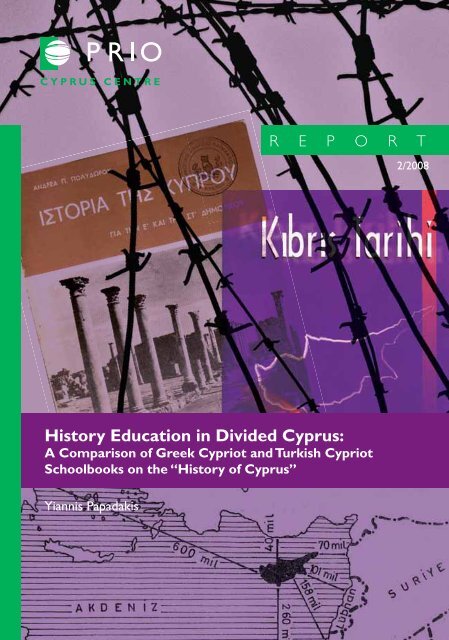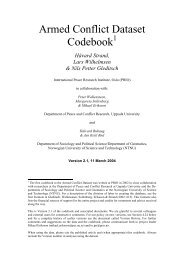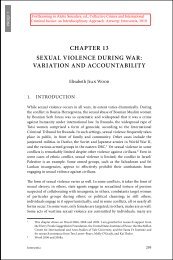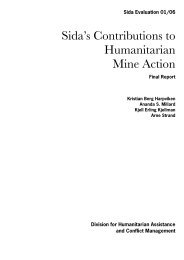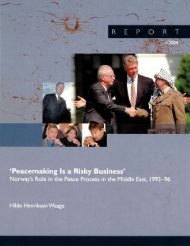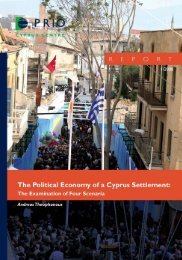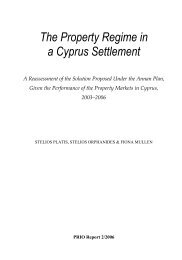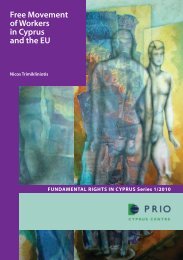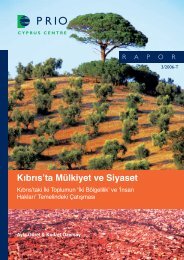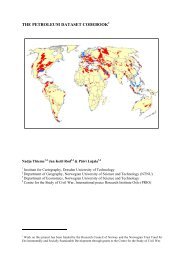History Education in Divided Cyprus: - PRIO
History Education in Divided Cyprus: - PRIO
History Education in Divided Cyprus: - PRIO
- No tags were found...
Create successful ePaper yourself
Turn your PDF publications into a flip-book with our unique Google optimized e-Paper software.
CYPRUS CENTRER E P O R T2/2008<strong>History</strong> <strong>Education</strong> <strong>in</strong> <strong>Divided</strong> <strong>Cyprus</strong>:A Comparison of Greek Cypriot and Turkish CypriotSchoolbooks on the “<strong>History</strong> of <strong>Cyprus</strong>”Yiannis Papadakis
Yiannis Papadakis holds a doctorate <strong>in</strong> social anthropology and is currentlyAssociate Professor at the Department of Social and Political Sciences at theUniversity of <strong>Cyprus</strong>. He is author of Echoes from the Dead Zone: Across the <strong>Cyprus</strong>Divide (I. B. Tauris, 2005), co-editor of <strong>Divided</strong> <strong>Cyprus</strong>: Modernity, <strong>History</strong> and anIsland <strong>in</strong> Conflict (Indiana University Press, 2006), and editor of a 2006 special issueof Postcolonial Studies on <strong>Cyprus</strong>. The present report is the result of work carriedout dur<strong>in</strong>g his employment at the <strong>PRIO</strong> <strong>Cyprus</strong> Centre <strong>in</strong> 2005–06 as ProjectLeader on <strong>History</strong> <strong>Education</strong>.
HISTORY EDUCATIONIN DIVIDED CYPRUS:A Comparison of Greek Cypriotand Turkish Cypriot Schoolbookson the “<strong>History</strong> of <strong>Cyprus</strong>”YIANNIS PAPADAKIS<strong>PRIO</strong> Report 2/2008
IInstitutt for fredforskn<strong>in</strong>gInternational Peace Research Institute, Oslo (<strong>PRIO</strong>)Hausmanns gate 7, NO-0186 OSLO, NorwayTel. +47 22 54 77 00Fax +47 22 54 77 01Email: <strong>in</strong>fo@prio.noWeb: www.prio.no<strong>PRIO</strong> encourages its researchers and research affiliates to publish their work <strong>in</strong> peerreviewedjournals and book series, as well as <strong>in</strong> <strong>PRIO</strong>ʼs own Report, Paper and Policy Briefseries. In edit<strong>in</strong>g these series, we undertake a basic quality control, but <strong>PRIO</strong> does not assuch have any view on political issues. We encourage our researchers actively to take part<strong>in</strong> public debates and give them full freedom of op<strong>in</strong>ion. The responsibility and honour forthe hypotheses, theories, f<strong>in</strong>d<strong>in</strong>gs and views expressed <strong>in</strong> our publications thus rest with theauthors themselves.© International Peace Research Institute, Oslo (<strong>PRIO</strong>), 2008All rights reserved. No part of this publication may be reproduced, stored <strong>in</strong> a retrieval system or utilized <strong>in</strong>any form or by any means, electronic, mechanical, photocopy<strong>in</strong>g, record<strong>in</strong>g, or otherwise, without permission<strong>in</strong> writ<strong>in</strong>g from the copyright holder(s).ISBN 978-82-7288-274-6Cover design:Photographs:Hilde Sørby, Bardus DesignYiannis Papadakis
CONTENTSCONTENTS ..................……………………………………………………………………….IIIFOREWORD...................................................................................................................VINTRODUCTION ............................................................................................................1GREEK CY<strong>PRIO</strong>T AND TURKISH CY<strong>PRIO</strong>T SCHOOL BOOKS:REFLECTIONS OF ETHNIC NATIONALISM .................................................................5GREEK CY<strong>PRIO</strong>T SCHOOL BOOKS........................................................................................5TURKISH CY<strong>PRIO</strong>T SCHOOL BOOKS ...................................................................................12THE NEW TURKISH CY<strong>PRIO</strong>T SCHOOL BOOKS: A PARADIGM SHIFT? ...............17MEMORY, NARRATIVE AND HISTORY ......................................................................27RECOMMENDATIONS.................................................................................................29
FOREWORD<strong>PRIO</strong>ʼs mission <strong>in</strong> <strong>Cyprus</strong> is to contribute to an <strong>in</strong>formed public debate on key issuesrelevant to an eventual settlement of the <strong>Cyprus</strong> problem. We hope to achieve this bydissem<strong>in</strong>at<strong>in</strong>g <strong>in</strong>formation, provid<strong>in</strong>g new analysis and facilitat<strong>in</strong>g dialogue. The <strong>PRIO</strong><strong>Cyprus</strong> Centre wishes to stimulate research cooperation and debates between GreekCypriots and Turkish Cypriots, as well as with<strong>in</strong> each of the two communities, and <strong>in</strong> the<strong>in</strong>ternational society.<strong>PRIO</strong> is therefore pleased to present <strong>PRIO</strong> Report 2/2008, written by Dr. YiannisPapadakis, the author of Echoes from the Dead Zone: Across the <strong>Cyprus</strong> Divide (2005).Papadakis has studied history text books, both Greek Cypriot and Turkish Cypriot, and hasengaged with history teachers from the islandʼs two ma<strong>in</strong> communities dur<strong>in</strong>g his research.His comparisons are em<strong>in</strong>ently <strong>in</strong>terest<strong>in</strong>g from both an academic and a political po<strong>in</strong>t ofview. With a solution to the <strong>Cyprus</strong> problem once more <strong>in</strong> sight, at least as a dist<strong>in</strong>ctpossibility, there are a range of challenges for peaceful coexistence that require attentionand debate. Cultures of education need to be seriously studied, and educational reform mayplay a fundamental role <strong>in</strong> <strong>Cyprus</strong>ʼs approach to globalization, and <strong>in</strong> the relationshipbetween the communities on the island. <strong>History</strong> education today and tomorrow will <strong>in</strong>fluencehow the com<strong>in</strong>g generations <strong>in</strong> <strong>Cyprus</strong> will understand themselves and their relations toothers for many decades to come.This is the seventh report from the <strong>PRIO</strong> <strong>Cyprus</strong> Centre s<strong>in</strong>ce it opened <strong>in</strong> 2005, but thefirst to specifically address education and how history is taught <strong>in</strong> the two parts of <strong>Cyprus</strong>.The report builds on our tradition of critical exam<strong>in</strong>ation and comparison of the situation <strong>in</strong>the Cypriot communities.The draft for this report went through an extensive peer review process to ensure that itmet the highest factual and academic standards. However, as always, the views expressed<strong>in</strong> the <strong>PRIO</strong> Report are the authorʼs own. They do not engage <strong>PRIO</strong> as an <strong>in</strong>stitution.STEIN TØNNESSONDirectorInternational Peace Research Institute, Oslo (<strong>PRIO</strong>)20 July 2008
INTRODUCTIONDepend<strong>in</strong>g on the sociohistorical context, the goals of history education may rangefrom the <strong>in</strong>culcation of national identity to the propagation of moral and politicalpositions, the exploration of otherness, the creation of empathy and presentation ofdiverse viewpo<strong>in</strong>ts, or historical analysis and the promotion of critical th<strong>in</strong>k<strong>in</strong>g, amongothers. 1 However, <strong>in</strong> many societies, especially those divided through ethnonational conflicts,history is often used to propagate a narrative focus<strong>in</strong>g on the suffer<strong>in</strong>g of the nation and tolegitimate its political goals. The suffer<strong>in</strong>g of others is silenced, their historical existence isquestioned, and socio-cultural <strong>in</strong>teractions are ignored. This has been how the “<strong>History</strong> of<strong>Cyprus</strong>” has been presented <strong>in</strong> the history schoolbooks of the two parts of the island. A newapproach to history teach<strong>in</strong>g has been undertaken s<strong>in</strong>ce 2004 by a newly elected to powerTurkish Cypriot leftist party (CTP), an approach that (it states) aims to develop a culture ofpeace while highlight<strong>in</strong>g cultural <strong>in</strong>teractions, <strong>in</strong>ternal divisions, and discont<strong>in</strong>uities. This isan <strong>in</strong>terest<strong>in</strong>g development for reasons both theoretical and political. How is a history that<strong>in</strong>cludes <strong>in</strong>ternal divisions to be written? And especially one that would <strong>in</strong>dicate <strong>in</strong>ternalviolence with<strong>in</strong> each side – <strong>in</strong> contrast to standard approaches present<strong>in</strong>g monolithicconstructions of Self and Other, where the Other is always the aggressor? What events,periods, pr<strong>in</strong>ciples and perspectives ignored <strong>in</strong> earlier approaches are highlighted now? Canthere be a mean<strong>in</strong>gful story from the perspective of more than one protagonist?The standard nationalist historical narrative posits the nation as a homogeneousprimordial entity, while, significantly, the new Turkish Cypriot approach traces the emergenceof national identity <strong>in</strong> <strong>Cyprus</strong> dur<strong>in</strong>g the 19th and 20th centuries follow<strong>in</strong>g a socialconstructivistparadigm. 2 This historical model has <strong>in</strong>terest<strong>in</strong>g implications for the notions ofmemory and trauma, blame and retribution, as well as for allow<strong>in</strong>g for the possibility ofmak<strong>in</strong>g choices regard<strong>in</strong>g political allegiance <strong>in</strong> the present. In contrast, the standard modelof history education employed <strong>in</strong> both parts of <strong>Cyprus</strong> has been obsessively pursu<strong>in</strong>g whathas been called an “identification stance,” that is, “stories of national orig<strong>in</strong>s and historicAn earlier, shorter version of this report was published as: Yiannis Papadakis, “Narrative, Memory and <strong>History</strong> <strong>Education</strong> <strong>in</strong> <strong>Divided</strong><strong>Cyprus</strong>: A Comparison of <strong>History</strong> Books on the ʻ<strong>History</strong> of <strong>Cyprus</strong>,ʼ” <strong>History</strong> and Memory, 20, no. 2, 2008: 128-148.1 For comprehensive analyses of the methods and aims of history education see: Keith Barton and L<strong>in</strong>da Levstik, Teach<strong>in</strong>g <strong>History</strong> for theCommon Good (New Jersey, 2004); Peter Seixas, ed., Theoriz<strong>in</strong>g Historical Consciousness (Toronto, 2004); Peter Sterns, Peter Seixasand Sam W<strong>in</strong>eburg, eds., Know<strong>in</strong>g, Teach<strong>in</strong>g and Learn<strong>in</strong>g <strong>History</strong>: National and International Perspectives (New York, 2000).2 For a comprehensive discussion of the primordialist and social-constructivist models see Anthony Smith, The Nation <strong>in</strong> <strong>History</strong>:Historiographical Debates about Ethnicity and Nationalism (Hanover, 2000).
2 <strong>History</strong> <strong>Education</strong> <strong>in</strong> <strong>Divided</strong> <strong>Cyprus</strong>turn<strong>in</strong>g po<strong>in</strong>ts [that] can create a sense of group membership and allegiance and historicsocietal achievements [that] can be used to justify contemporary social arrangements orpolitical actions.” 3 This entails the use of the narrative form whereby a s<strong>in</strong>gle actor, thenation, is present from beg<strong>in</strong>n<strong>in</strong>g to end as the storyʼs protagonist, which students are calledto identify with <strong>in</strong> all its glory or suffer<strong>in</strong>g. <strong>History</strong> is presented as a grand narrative ofnational achievements and struggles, with the national community emerg<strong>in</strong>g as the onlypossible choice of political allegiance. As will be more fully argued <strong>in</strong> the conclusion, thisapproach collapses the vital (<strong>in</strong> historical terms) dist<strong>in</strong>ction between past and present anddenies the possibility of choos<strong>in</strong>g the political community one can belong to <strong>in</strong> the present. 4The recent history of <strong>Cyprus</strong> has been marked by multiple conflicts and foreign<strong>in</strong>terventions, which provide the socio-political context with<strong>in</strong> which the books underdiscussion were produced. A basic outl<strong>in</strong>e of the islandʼs recent political history, highlycontested though it is, is necessary as background. A word of caution regard<strong>in</strong>g thelimitations and methodology of this study is equally necessary. Discuss<strong>in</strong>g the history of<strong>Cyprus</strong> is ak<strong>in</strong> to stepp<strong>in</strong>g <strong>in</strong>to a political and academic m<strong>in</strong>efield, given that most workswere written by Greek Cypriot, Turkish Cypriot, Greek, Turkish or British authors <strong>in</strong> periodsof <strong>in</strong>tense violence. Most authors, implicitly or explicitly, used history for the legitimation oftheir own sideʼs political objectives, and the rejection of othersʼ objectives. 5 That I am not ahistorian, but a Greek Cypriot social anthropologist, poses additional challenges. In thisreport I employ a comparative approach as a critical device of defamiliarisation, and I use atheoretical discussion to <strong>in</strong>dicate the structural problems and limitations of the historicalnarratives presented <strong>in</strong> history books by focus<strong>in</strong>g on the underly<strong>in</strong>g ideological pr<strong>in</strong>ciplesguid<strong>in</strong>g their representations of history. For analysis of the history books, I have drawn onUNESCOʼs guidel<strong>in</strong>es for textbook research, which stress the importance of qualitativeanalysis to “reveal underly<strong>in</strong>g assumptions.” 6 For this reason, this study focuses more onbooks that present the whole of history from “beg<strong>in</strong>n<strong>in</strong>g to end,” s<strong>in</strong>ce this enables3 Barton and Levstik, Teach<strong>in</strong>g <strong>History</strong>, 45.4 Barton and Levstik, Teach<strong>in</strong>g <strong>History</strong>, 49, 62-63.5 For general critiques of the British and Greek Cypriot approaches to the history of <strong>Cyprus</strong> see: Michael Given, Symbols, Power and theConstruction of City-K<strong>in</strong>gdoms of Archaic and Classical <strong>Cyprus</strong> (Ph.D. diss., University of Cambridge, 1991); Michael Given, “Star of theParthenon, Cypriot Melange: <strong>Education</strong> and Representation <strong>in</strong> Colonial <strong>Cyprus</strong>,” Journal of Mediterranean Studies 7, no. 1 (1997): 59-82;Yiannis Papadakis, Perceptions of <strong>History</strong> and Collective Identity: A Study of Contemporary Greek Cypriot and Turkish Cypriot Nationalism(Ph.D. diss., University of Cambridge, 1993), 25-51. For general critiques of Greek Cypriot schoolbooks on the history of <strong>Cyprus</strong> see:Loris Koullapis, “Ideologikoi Prosanatolismoi tis Ell<strong>in</strong>okypriakis Ekpaidevsis me Emphasi sto Mathima tis Istorias” [Ideological Orientationsof Greek Cypriot <strong>Education</strong> with Emphasis on the Lesson of <strong>History</strong>], Syghrona Themata, nos. 68-69-70 (1998-1999): 276-296; LorisKoullapis, “The Subject of <strong>History</strong> <strong>in</strong> the Greek Cypriot <strong>Education</strong>al System: A Subset of the Greek Nation,” <strong>in</strong> Christ<strong>in</strong>a Koullouri, ed.,Clio <strong>in</strong> the Balkans: The Politics of <strong>History</strong> <strong>Education</strong> (Thessaloniki, 2002), 406-422; AKTI, Ekthesi gia ta Vivlia Istorias kai Logotechniastis Ektis Dimotikou se Schesi me t<strong>in</strong> Proothisi tis Vias kai tou Ethnikismou [Report on <strong>History</strong> and Literature Books of 6th Grade PrimarySchools <strong>in</strong> Relation to Issues of Violence and Nationalism] (Nicosia, 2004). For general critiques of Turkish Cypriot approaches to historyand of schoolbooks see: Niyazi Kizilyürek, “National Memory and Turkish Cypriot Textbooks,” <strong>in</strong> Christ<strong>in</strong>a Koullouri, ed., Clio <strong>in</strong> theBalkans: The Politics of <strong>History</strong> <strong>Education</strong> (Thessaloniki, 2002), 431-442; POST, Pilot Application for the <strong>History</strong> and Literature Books ofthe 5th Grade of the Elementary School (Nicosia, 2004); POST, Textual and Visual Analyses of Lower Secondary School <strong>History</strong>Textbooks: Comparative Analysis of the Old and the New Textbooks (Nicosia, 2007).6 Falk P<strong>in</strong>gel, UNESCO Guidebook on Textbook Research and Textbook Revision (Hannover, 1999), 45.
Introduction3exam<strong>in</strong>ation of (the whole) narrative, the key analytical tool employed here. 7 The keypr<strong>in</strong>ciples of analysis adopted from the UNESCO handbook <strong>in</strong>volve the exam<strong>in</strong>ation of:terms, context and boundaries; the representation of group identity; cont<strong>in</strong>uity, legitimacyand exclusion; and historyʼs characters/protagonists. 8Three centuries of Ottoman rule <strong>in</strong> <strong>Cyprus</strong> were succeeded by British colonialism <strong>in</strong>1878. The 20th century witnessed the gradual rise, first, of Greek nationalism and, later, ofTurkish nationalism, with Greek Cypriots support<strong>in</strong>g enosis, the Union of <strong>Cyprus</strong> with Greece,and Turkish Cypriots demand<strong>in</strong>g taksim, the partition of <strong>Cyprus</strong>. From 1955 the GreekCypriot struggle was led by an armed organization called EOKA [National Organisation ofCypriot Fighters], and <strong>in</strong> 1958 Turkish Cypriots set up their own armed group called TMT[Turkish Resistance Organization]. In 1960, <strong>Cyprus</strong> became an <strong>in</strong>dependent state, theRepublic of <strong>Cyprus</strong>, with a population of 80% Greek Cypriots and 18% Turkish Cypriots, anoutcome that frustrated both communitiesʼ political goals. Both ethnic groups cont<strong>in</strong>ued topursue their separate objectives and <strong>in</strong> 1963 <strong>in</strong>ter-ethnic fight<strong>in</strong>g broke out <strong>in</strong> <strong>Cyprus</strong>. Thiscont<strong>in</strong>ued <strong>in</strong>termittently until 1967, with Turkish Cypriots bear<strong>in</strong>g the heavier cost <strong>in</strong> termsof casualties and around a fifth of their population be<strong>in</strong>g displaced. With the rise to power <strong>in</strong>Greece of a military junta, the Greek Cypriot leadership gradually edged away from Unionwith Greece and sought <strong>in</strong>stead to preserve the <strong>in</strong>dependence of <strong>Cyprus</strong> from attempts byAthens to dictate politics, and to solve the <strong>in</strong>ter-communal dispute. While armedconfrontations between Turkish and Greek Cypriots ceased after 1967, a new conflictdeveloped – this time among Greek Cypriots. With the support of the Greek junta, a smallgroup of right-w<strong>in</strong>g extremists call<strong>in</strong>g itself EOKA B staged a coup <strong>in</strong> 1974 aga<strong>in</strong>st theislandʼs President, Archbishop Makarios, <strong>in</strong> order to br<strong>in</strong>g about Union. This led to a militaryoffensive by Turkey divid<strong>in</strong>g the island, followed by population displacements of most GreekCypriots to the south and Turkish Cypriots northwards. Greek Cypriots suffered the most <strong>in</strong>terms of people killed, miss<strong>in</strong>g and all other social traumas of war and dislocation, witharound one-third of a total of 600,000 Greek Cypriots displaced to the southern side. Around45,000 Turkish Cypriots were also displaced to the northern side. In 1983, the TurkishCypriot authorities unilaterally declared the establishment of their own state <strong>in</strong> northern<strong>Cyprus</strong>, the Turkish Republic of Northern <strong>Cyprus</strong> (TRNC), which has s<strong>in</strong>ce rema<strong>in</strong>ed<strong>in</strong>ternationally unrecognized except by Turkey. For much of the 20th century another conflictpersisted, this time with<strong>in</strong> each ethnic group between forces of the Right and the Left, eachwith its own record of violence aga<strong>in</strong>st the Left.7 All major Turkish Cypriot schoolbooks on the history of <strong>Cyprus</strong> <strong>in</strong> use until 2006 when this study ends are discussed here. The ma<strong>in</strong>Greek Cypriot schoolbooks discussed are the primary level schoolbooks for 5th and 6th grade aimed at eleven- and twelve-year-oldstudents and the secondary level book for high school (Gymnasium). This book is a summary of all the other secondary level schoolbooksthat cover specific periods: Koullapis, “Ideologikoi Prosanatolismoi,” 281.8 P<strong>in</strong>gel, UNESCO Guidebook, 24, 26, 27, 47.
Chapter 1GREEK CY<strong>PRIO</strong>T ANDTURKISH CY<strong>PRIO</strong>T SCHOOLBOOKS:REFLECTIONS OF ETHNIC NATIONALISMDespite their different political goals, the two nationalisms that emerged <strong>in</strong> <strong>Cyprus</strong>shared the same form, namely, an ethnic nationalism 9 stress<strong>in</strong>g common history,descent, language, culture and religion with the people of the “motherlands” Turkeyand Greece. Greek Cypriots and Turkish Cypriots were only taught the history of Greeceand the history of Turkey respectively, while the history of <strong>Cyprus</strong> was only relativelyrecently <strong>in</strong>troduced and with considerably less time allotted. 10 On the Greek Cypriot side,the history of <strong>Cyprus</strong> has been presented as an extension of the history of Greece, and onthe Turkish Cypriot side as an extension of the history of Turkey. 11Greek Cypriot SchoolbooksThe general framework and basic pr<strong>in</strong>ciples of the Greek Cypriot schoolbooks are derivedfrom the dom<strong>in</strong>ant model of the history of Greece. This model posits three key periods:ancient Greece, medieval Greece (the “glorious Byzant<strong>in</strong>e Empire”), and modern Greece(the creation of the Greek state dur<strong>in</strong>g the 19th and 20th centuries). Emphasis is placed onancient Greece as the beg<strong>in</strong>n<strong>in</strong>g of history, succeeded by “foreign dom<strong>in</strong>ation” until the riseof the Byzant<strong>in</strong>e Empire (treated as a glorious “Greek” empire) and f<strong>in</strong>ally liberation from the“Turkish yoke.” 12 “Hellenism” is the transcendental, transhistorical category <strong>in</strong>form<strong>in</strong>g thishistorical discourse, which posits the historical cont<strong>in</strong>uity of Hellenism from ancient tomodern times. Turks emerge as Hellenismʼs barbaric archenemy accord<strong>in</strong>g to this historicalnarrative. The cover of the Greek primary school history textbook (Image 1) on the history ofGreece starkly illustrates this. It presents a group of Greek fighters aga<strong>in</strong>st a background ofTurks hold<strong>in</strong>g Greeks captive, while one Turk wields a curved sword ready to behead them.9 Anthony Smith, National Identity (London, 1991).10 See Koullapis, “Ideologikoi Prosanatolismoi”; and Kizilyrek, “National Memory.”11 See Koullapis, “The Subject of <strong>History</strong>”; and Kizilyrek, “National Memory.”12 For comprehensive critical discussions of Greek history schoolbooks see Anna Frangoudaki and Thalia Dragona, eds, “Ti e<strong>in</strong>ʼ i Patridamas?” Ethnokentrismos st<strong>in</strong> Ekpaidevsi “[What is Our Country? Ethnocentrism <strong>in</strong> <strong>Education</strong>”] (Athens, 1997). For critical comparativediscussions of Greek and Turkish schoolbooks see: Iraklis Millas, Eikones Ell<strong>in</strong>on kai Tourkon: Scholika Vivlia, Istoriografia, Logotechniakai Ethnika Stereotypa [Images of Greeks and Turks: Schoolbooks, Historiography, Literature and National Stereotypes] (Athens, 2001);Loris Koullapis, “The Presentation of the Period 1071-1923 <strong>in</strong> Greek and Turkish Textbooks Between 1950-2000,” InternationalTextbook Research 24, no. 3 (2002): 279-304.
6 <strong>History</strong> <strong>Education</strong> <strong>in</strong> <strong>Divided</strong> <strong>Cyprus</strong>Image 1. Source: OEDB, Sta Neotera Hronia- Istoria St Dimotikou,(Athens, n.d.), front cover.“<strong>Cyprus</strong> is and has been Greek and noth<strong>in</strong>g but Greek” is the message conveyed by thecover of the major Greek Cypriot primary-level schoolbook on the history of <strong>Cyprus</strong>, whichshows a row of ancient columns (Image 2); as for its people: “Cypriots were and areChristian Orthodox.” 13 This book covers the Roman period to the present, thus present<strong>in</strong>gthe most complete narrative of the whole of the history of <strong>Cyprus</strong> <strong>in</strong> primary school. 14 Fromthe start it subsumes the history of <strong>Cyprus</strong> with<strong>in</strong> the history of Greece with the two firstsections entitled “The Conquest of Greece by the Romans” followed by “The Conquest of<strong>Cyprus</strong> by the Romans.” This and the other Greek Cypriot schoolbooks to be discussedfollow the periodisation of history, a precedent established for recount<strong>in</strong>g the history ofGreece, by present<strong>in</strong>g history “from above” as a succession of empires/rulers with the13 Andreas Polydorou, Istoria tis Kyprou [<strong>History</strong> of <strong>Cyprus</strong>] (Nicosia, 1991), 58. That the cover photo actually shows Roman columns (asthe book <strong>in</strong>dicates <strong>in</strong>side) is a po<strong>in</strong>t that primary school students could hardly grasp s<strong>in</strong>ce columns are immediately associated withancient Greek monuments. For the most detailed critiques of this book, which also support the f<strong>in</strong>d<strong>in</strong>gs presented here see: AKTI,Ekthesi gia ta Vivlia Istorias; Kalypso Charalampous and Elena Mihi, O Ethnikos Eaftos kai o Ethnikos Allos sto Egheiridio IstoriasAndrea Polydorou [The National Self and National Other <strong>in</strong> the <strong>History</strong> Schoolbook of Andreas Polydorou], unpublished study for therequirements of the MA <strong>in</strong> <strong>Education</strong>, University of <strong>Cyprus</strong> (Nicosia, 2006). I would like to note that this and all other translations fromGreek or Turkish are my own.14 Earlier historical periods are covered <strong>in</strong> previous primary school classes.
Greek Cypriot and Turkish Cypriot schoolbooks: Reflections of Ethnic Nationalism7adjective –kratia (dom<strong>in</strong>ation) signify<strong>in</strong>g oppression, used for everyone but (ancient) Greeksor Byzant<strong>in</strong>es, as <strong>in</strong> Frangokratia, Enetokratia, Tourkokratia, Agglokratia (Frankish, Venetian,Turkish, and English Dom<strong>in</strong>ation). In all the books, “Cypriot Hellenism” is the central actorof history from beg<strong>in</strong>n<strong>in</strong>g to end.Image 2. Source: Andreas Polydorou,Istoria tis Kyprou (Nicosia, 1991), front cover.All the books employ the term Cypriots (Kyprioi) as equivalent to Greeks (Ell<strong>in</strong>es), oftenwith<strong>in</strong> the same sentence or paragraph. As Koullapis rightly argued, “this practice <strong>in</strong>culcates<strong>in</strong> the historical consciousness of Greek Cypriots the belief that from the period of theMycenaeans to the present there have never been any other <strong>in</strong>digenous population groupsexcept the Greeks or, at the very least, that the presence of any Others was and isparasitic.” 15 As a secondary-level schoolbook states <strong>in</strong> the foreword: “Many peoples passedover <strong>Cyprus</strong> or conquered her… But its <strong>in</strong>habitants safeguarded its Hellenic charactercreated s<strong>in</strong>ce the Mycenaeans settled <strong>in</strong> <strong>Cyprus</strong>…” 16 This “Hellenisation thesis,” reproduced<strong>in</strong> all relevant schoolbooks, has attracted considerable academic critique, although ma<strong>in</strong>ly15 Koullapis, “Ideologikoi Prosanatolismoi,” 283. As Koullapis also argues, this practice has been employed <strong>in</strong> all history books. Forexamples of this practice see Polydorou, Istoria tis Kyprou, 91, 107, 108, 110.16 YAP (Ypiresia Anaptyxis Programmaton), Istoria tis Kyprou, Neolithiki –Romaiki [<strong>History</strong> of <strong>Cyprus</strong>, Neolithic-Roman] (Nicosia, 2005), 2.
8 <strong>History</strong> <strong>Education</strong> <strong>in</strong> <strong>Divided</strong> <strong>Cyprus</strong>from outside <strong>Cyprus</strong>. 17 Accord<strong>in</strong>g to the logic of this model, others (Turkish Cypriots, forexample) have (historically speak<strong>in</strong>g) no rightful place <strong>in</strong> <strong>Cyprus</strong>; hence the category“Cypriots” is constantly used <strong>in</strong> a manner that excludes them. As the previous quote<strong>in</strong>dicates, the arrival of the Mycenaeans is considered the most important historical eventthat has sealed the Hellenic character of <strong>Cyprus</strong>.Image 3. Source: YAP, Istoria tis Kyprou- Gymnasio(Nicosia, 2005), p.105.Just as, accord<strong>in</strong>g to the logic of ethnic nationalism, the Byzant<strong>in</strong>es are treated asGreeks, the Ottomans are presented as Turks, with the primary-level schoolbook conta<strong>in</strong><strong>in</strong>ga section on “The Conquest of Nicosia by the Turks” – beg<strong>in</strong>n<strong>in</strong>g as follows: “It was obviousthat one day the Turks would try to grab <strong>Cyprus</strong>. The way that the state of the Sultanexpanded, little <strong>Cyprus</strong> appeared like a weak mouse <strong>in</strong> the claws of a wild lion.” 18 This setsthe tone regard<strong>in</strong>g the Turks, who appear as an expansionist and bestially savage people.The Ottoman period is presented <strong>in</strong> this and other schoolbooks <strong>in</strong> exclusively negativeterms: “As a part of the Ottoman Empire, <strong>Cyprus</strong> followed the fate of the rest of Hellenism.17 For a general outl<strong>in</strong>e of the arguments and critiques see Natasha Leriou, “Construct<strong>in</strong>g an Archaeological Narrative: The Hellenisationof <strong>Cyprus</strong>,” Stanford Journal of Archaeology, 1 (2002):1-32.18 Polydorou, Istoria tis Kyprou, 69.
Greek Cypriot and Turkish Cypriot schoolbooks: Reflections of Ethnic Nationalism9Insults, humiliations, oppression.” 19 Numerous pages of gruesomely detailed descriptionsand graphic images of torture and slaughter are provided <strong>in</strong> the books, like the one show<strong>in</strong>ga “Turk” impal<strong>in</strong>g a “Greek” (Image 3). The primary-level schoolbook subsequently asks thestudents: “What k<strong>in</strong>ds of torture did the Cypriots suffer at the hands of the Turks?” 20 Incontrast, the Byzant<strong>in</strong>e adm<strong>in</strong>istration is shown <strong>in</strong> a positive light with “Byzant<strong>in</strong>e civilizationflourish<strong>in</strong>g.” 21 Given that for Turkish Cypriots the ascription “Turks” is constantly employed, 22this presents them as part of the larger historical category of Turks, who are shown as abloodthirsty, hostile and barbaric people. The structure of the Greek Cypriot narrative issummarized <strong>in</strong> Table 1. <strong>History</strong> beg<strong>in</strong>s with the arrival of “Greeks” <strong>in</strong> <strong>Cyprus</strong>; “Greeks (of<strong>Cyprus</strong>)” emerge as the protagonist and moral center of the story from whose perspectiveevents are evaluated, 23 and 1974 subsequently emerges as the tragic end for the “Greeksof <strong>Cyprus</strong>.” As White argues, the use of the narrative form is predicated on a notion ofcont<strong>in</strong>uity, <strong>in</strong> this case of the presence of a s<strong>in</strong>gle central actor, namely the (Greek) nationfrom beg<strong>in</strong>n<strong>in</strong>g to end. The use of a narrative form presents history as a moral story fromwhich stem moral <strong>in</strong>junctions that members of the (national) community ought to obey. Inother words, the narrative form presents didactic stories. When history is presented <strong>in</strong> thisform, it claims total objectivity s<strong>in</strong>ce the events appear to tell themselves. 24The period of <strong>in</strong>terethnic violence <strong>in</strong> the 1960s is described only briefly, and from anexclusively Greek Cypriot viewpo<strong>in</strong>t. Turkish Cypriots are described as “mut<strong>in</strong>eer Turks”stag<strong>in</strong>g provocations, and are held responsible for the conflict. This period is presented asa period of aggression by “Turks” 25 (Turkey and Turkish Cypriots) aga<strong>in</strong>st the “Greeks” andshown as a period of mostly “Greek” suffer<strong>in</strong>g, when Turkish fighter planes “spreadcatastrophe and death among the civilian population” (mean<strong>in</strong>g the Greek Cypriots), 26 evenif the Turkish Cypriot suffer<strong>in</strong>g then was by any measure far greater than that of GreekCypriots. 27 Nonetheless, the primary education schoolbook later describes the period of1960-1974 as follows: “From 1960 when the Republic was created to 1974 <strong>Cyprus</strong> enjoyedunprecedented development <strong>in</strong> all sectors. The population had full employment and its life19 YAP, Istoria tis Kyprou, Gymnasio [<strong>History</strong> of <strong>Cyprus</strong>, Gymnasium] (Nicosia, 2005), 92.20 Polydorou, Istoria tis Kyprou, 91.21 YAP, Istoria tis Kyprou, Gymnasio, 66. On the contrast<strong>in</strong>g presentations of the Byzant<strong>in</strong>e period and Ottoman period <strong>in</strong> Greekschoolbooks as “paradise” and “hell” and vice versa <strong>in</strong> Turkish schoolbooks, see Koullapis, “The Presentation of the Period 1071-1923.”22 With the exception that there are rare mentions of “Turkish Cypriots” at the very end of the books.23 Hayden White, The Content of the Form: Narrative Discourse and Historical Representation (Baltimore and London, 1990), 1-25.24 White, The Content of the Form, 3, 10, 25.25 Polydorou, Istoria tis Kyprou, 116.26 Ibid., 116.27 For the most exhaustive academic discussion of the 1960s with statistics of those killed, miss<strong>in</strong>g and displaced <strong>in</strong> both communitiessee Richard Patrick, Political Geography and the <strong>Cyprus</strong> Problem (Waterloo, 1976).
10 <strong>History</strong> <strong>Education</strong> <strong>in</strong> <strong>Divided</strong> <strong>Cyprus</strong>constantly improved.” 28 This statement ignores the liv<strong>in</strong>g conditions of Turkish Cypriots, afifth of whom were displaced and lived <strong>in</strong> poverty, fear and isolation dur<strong>in</strong>g much of the1960s. For the same period, the Turkish Cypriot leadership is (correctly) presented aspursu<strong>in</strong>g a partitionist policy, but, with the exception of a brief mention <strong>in</strong> one book, 29 theGreek Cypriot <strong>in</strong>sistence on Union with Greece culm<strong>in</strong>at<strong>in</strong>g <strong>in</strong> a unanimous pro-Union voteat the Parliament dur<strong>in</strong>g 1967 is not discussed.As for other religious and ethnic groups, the primary-level schoolbook presentsnumerous racist stereotypes. The Arabs “had to follow their herds of sheep, and camels andhorses <strong>in</strong> search of food. They lived nomadic lives. That is how most of them live today.” OfMuslims, it is said that “bl<strong>in</strong>d with religious fanaticism, they rush out like lightn<strong>in</strong>g aga<strong>in</strong>st theneighbor<strong>in</strong>g countries.” 30 Accord<strong>in</strong>g to a study employ<strong>in</strong>g content analysis, this book<strong>in</strong>cludes 100 negative references to “national others” (the bulk of which refer to Turks) andonly two negative references to the “national self,” 31 as well as five positive references to“national others” and 35 to the “national self.” In order to establish Greek supremacy, theauthor has no qualms <strong>in</strong> collaps<strong>in</strong>g the crucial dist<strong>in</strong>ction between legend/myth and history,the foundational dist<strong>in</strong>ction of the discipl<strong>in</strong>e of history. In a section present<strong>in</strong>g the legends ofDigenis Akritas, a legendary guardian of the Byzant<strong>in</strong>e borders, the author constantly slidesbetween legend and history, past and present, by present<strong>in</strong>g legends as history only toexclaim <strong>in</strong> the end: “So what if these stories are legend! So what if Digenis never set foot <strong>in</strong><strong>Cyprus</strong>! He was the new Hercules of the Greeks. His persona embodies Bravery andVirtue… and with his fearless brave young men he guards Greeks from all evil.” 32For the Ottoman Period all relevant books discuss the practice of “exislamismoi” (forcedislamization). More attention is given to this issue <strong>in</strong> the secondary schoolbook on Medieval/Modern history, which employs a number of secondary sources with titles like “The GreekOrig<strong>in</strong> of Turkish Cypriots” argu<strong>in</strong>g that Turkish Cypriots are primarily descendants ofislamicized Greeks <strong>in</strong> <strong>Cyprus</strong> and that even the people <strong>in</strong>itially brought over from Anatoliaby the Ottoman authorities were themselves orig<strong>in</strong>ally of Greek stock. 33 Irrespective of thehistorical extent of conversions, this is an essentialist argument that relies on pr<strong>in</strong>ciples ofracial descent as determ<strong>in</strong><strong>in</strong>g identity, with the term “race (phyli)” be<strong>in</strong>g uncritically presented<strong>in</strong> a number of cases <strong>in</strong> the schoolbooks. 34 This argument denies identity to Turkish Cypriotsand consequently it denies them the possibility of posit<strong>in</strong>g any political claims s<strong>in</strong>ce they do28 Polydorou, Istoria tis Kyprou, 117.29 YAP, Istoria tis Kyprou, Mesaioniki-Neoteri ([<strong>History</strong> of <strong>Cyprus</strong>, Medieval-Modern] (Nicosia, 2005), 285.30 Polydorou, Istoria tis Kyprou, 35, 36.31 Kalypso Charalampous and Elena Mihi, O Ethnikos Eaftos, 38.32 Polydorou, Istoria tis Kyprou, 42. On the merg<strong>in</strong>g of myth and history <strong>in</strong> the history schoolbooks of Greece see Yannis Hamilakis, “Learn<strong>History</strong>! Antiquity, National Narrative, and <strong>History</strong> <strong>in</strong> Greek <strong>Education</strong>al Textbooks,” <strong>in</strong> K.S. Brown and Yannis Hamilakis, eds., TheUsable Past: Greek Metahistories (Oxford, 2003), 39-67.33 YAP, Istoria tis Kyprou Mesaioniki-Neoteri, 154-163. See also: Polydorou, Istoria tis Kyprou, 101; YAP, Istoria tis Kyprou, Gymnasio, 98.34 YAP, Istoria tis Kyprou, Mesaioniki-Neoteri, 162, 234.
Greek Cypriot and Turkish Cypriot schoolbooks: Reflections of Ethnic Nationalism11not exist as a “real” ethnic group. The <strong>in</strong>terest <strong>in</strong> the descent of Turkish Cypriots emergedamong Greek Cypriot historians dur<strong>in</strong>g the tumultuous period of the 1960s and, once their“Greek orig<strong>in</strong>” was established, it was argued that they should be “<strong>in</strong>corporated(afomoiothoun)” back <strong>in</strong>to the Greek community and that, given that they too were <strong>in</strong> realityGreeks, then Union with Greece was absolutely legitimate. 35 Needless to say, the “Greeksof <strong>Cyprus</strong>” are presented as unproblematically Greek throughout history and no questionsregard<strong>in</strong>g their descent/orig<strong>in</strong> are ever raised. 36 Unsurpris<strong>in</strong>gly, they are press<strong>in</strong>gly raised<strong>in</strong> the Turkish Cypriot schoolbooks.The 2004 Report of the Committee for <strong>Education</strong>al Reform, which exam<strong>in</strong>ed the entireGreek Cypriot educational system, confirms the major f<strong>in</strong>d<strong>in</strong>gs presented above not<strong>in</strong>g thatthese pervade not just history teach<strong>in</strong>g but the educational system overall. This is describedas “Hellenoethnocentric and religious <strong>in</strong> character” not<strong>in</strong>g that “the ideologico-politicalframework of contemporary Cypriot [sic] education rema<strong>in</strong>s Greek-Cypriot centered, narrowlyethnocentric and culturally monolithic.” 37 Occasional remarks made by Greek Cypriot officialson multiculturalism, critical <strong>in</strong>quiry and a democratic, <strong>in</strong>teractive educational framework arerejected as rhetorical and not followed through <strong>in</strong> actual educational practices, neither <strong>in</strong>the general “educational system, the curriculum or the books.” 38 The Council of EuropeRecommendation 2001 (15) on the teach<strong>in</strong>g of history <strong>in</strong> 21st century Europe calls for theadoption of the follow<strong>in</strong>g pr<strong>in</strong>ciples: “… a history-teach<strong>in</strong>g syllabus <strong>in</strong>tended to elim<strong>in</strong>ateprejudice and emphasiz<strong>in</strong>g positive mutual <strong>in</strong>fluences between different countries… developrespect for all k<strong>in</strong>ds of differences… be a decisive factor <strong>in</strong> reconciliation, recognition,understand<strong>in</strong>g and mutual trust between peoples…to analyse critically and responsibly…through open debate based on multiperspectivity, especially on controversial andsensitive issues… must not be an <strong>in</strong>strument of ideological manipulation, of propaganda orused for the promotion of xenophobic, racist or anti-Semitic ideals.” Despite the adoption ofthis recommendation by the Republic of <strong>Cyprus</strong>, the current history books oppose ratherthan endorse its pr<strong>in</strong>ciples.After 1974, the reunification of <strong>Cyprus</strong> and the expulsion of Turkish settlers and immigrantsfrom the north became the unanimously supported Greek Cypriot aims. A new historical35 Papadakis, Perceptions of <strong>History</strong>, 34-41.36 On this po<strong>in</strong>t see also Koullapis, Ideologikoi Prosanatolismo, 284-285.37 EEM (Epitropi Ekpaideftikis Metarrythmisis), Demokratiki kai Anthrop<strong>in</strong>i Paideia st<strong>in</strong> Evrokypriaki Politia [Democratic and Humanistic<strong>Education</strong> <strong>in</strong> the Eurocypriot Polity] (Nicosia, 2004), 36, 63. See also similar comments made on pp. 94-96.38 Ibid., 102. It is an open question whether the recommendations of this report, which has come under major attack, will be implemented.The current left-w<strong>in</strong>g AKEL government of the Republic of <strong>Cyprus</strong> appears determ<strong>in</strong>ed to proceed with significant changes, whileAndreas Demetriou, the current M<strong>in</strong>ister of <strong>Education</strong> , has stated that chang<strong>in</strong>g history books and reform<strong>in</strong>g history education, as partof a wider reform of the educational system, is one of his priorities: Stefanos Evripidou, “Fight<strong>in</strong>g Inertia <strong>in</strong> Our Schools,” Sunday Mail(Nicosia, <strong>Cyprus</strong>), July 6, 2008. Some NGOs are also engaged with issues related to history education, the most active be<strong>in</strong>g the multicommunalAssociation for Historical Dialogue and Research (www.hisdialresearch.org).
12 <strong>History</strong> <strong>Education</strong> <strong>in</strong> <strong>Divided</strong> <strong>Cyprus</strong>outlook was officially propagated that now posited Turkish Cypriots as “Turkish Cypriots”with whom “Greek Cypriots” had formerly coexisted. This version of history proposed thatthe past proved that reunification was possible s<strong>in</strong>ce the two communities had peacefullycoexisted <strong>in</strong> the past. 39 The shift <strong>in</strong> ascriptions (from Greeks to Greek Cypriots and Turks toTurkish Cypriots) was employed to <strong>in</strong>dicate their commonality and to sharply dist<strong>in</strong>guishTurkish Cypriots from both Turkish settlers and immigrants, and Turks <strong>in</strong> general who werethe 1974 aggressors, designated as the “Turkish Attila.” This has not been translated <strong>in</strong>toeducational practice as far as the books exam<strong>in</strong>ed are concerned, where mentions ofevents of coexistence and cooperation are highly exceptional and where Turkish Cypriotsare presented as “Turks,” as part of the historic enemy and the opposite of “Greeks.” Rather,the current schoolbooks follow the historical model dom<strong>in</strong>ant among Greek Cypriot historiansbefore 1960 when they sought to legitimate Union with Greece. 40 Recent studies conductedon primary-level schoolchildrenʼs attitudes f<strong>in</strong>d that they express strongly negative stereotypesfor both Turks and Turkish Cypriots, that they have difficulty <strong>in</strong> dist<strong>in</strong>guish<strong>in</strong>g between them,and that teachers do not try to draw any dist<strong>in</strong>ction dur<strong>in</strong>g teach<strong>in</strong>g practices. 41 Strongnegative stereotypes are also expressed for all other ethnonational groups exam<strong>in</strong>ed exceptWestern Europeans, while aff<strong>in</strong>ity with the Greeks is justified as based on literally shar<strong>in</strong>gthe same blood. 42 A study of Greek Cypriot youth (15-23 years old) as well as their highschool teachers and headmasters, <strong>in</strong>dicated that Turkish Cypriots emerged as the mostrejected category by all, with categories like Gypsies (Roma), Arab workers, foreign artistes(a euphemism for prostitutes), and Asian domestic workers follow<strong>in</strong>g beh<strong>in</strong>d. 43Turkish Cypriot SchoolbooksThe Turkish Cypriot school textbooks used until recently (2004) follow the same logic ofethnic nationalism, with the problems previously identified for Greek Cypriot books nowamplified, to the extent that these textbooks could themselves provide textbook examplesof all that can go wrong with a history textbook. Vehbi Serter, author and co-author of twoof the three major books discussed, was an active member of TMT and subsequentlymember of the nationalist right-w<strong>in</strong>g party UBP (National Unity Party). The books wereproduced at periods when the Right monopolized power on the Turkish Cypriot side with the39 Papadakis, Perceptions of <strong>History</strong>, 42-51.40 Ibid., 27-34.41 See: Chara Makriyianni, <strong>History</strong>, Museums and National Identity <strong>in</strong> a <strong>Divided</strong> Country: Greek Cypriot Childrenʼs Experience of MuseumVisits (Unpublished PhD Diss., University of Cambridge, 2006); Spyros Spyrou, “Those on the Other Side: Ethnic Identity andImag<strong>in</strong>ation <strong>in</strong> Greek Cypriot Childrenʼs Lives,” <strong>in</strong> Helen Schwartzman, ed., Children and Anthropology: Perspectives for the 21stCentury, 167-185 (Westport, 2001); Spyros Spyrou, “Images of the ʻOtherʼ: ʻThe Turkʼ <strong>in</strong> Greek Cypriot Childrenʼs Imag<strong>in</strong>ation,” Race,Ethnicity and <strong>Education</strong> 5, no. 3 (2002): 255-272.42 Stavroula Philippou, “Anaparastontas Ethnikes Exoomades: Oi Alloi Mesa apo ta Matia Dekahronon Ell<strong>in</strong>okyprion Paidion”(Represent<strong>in</strong>g National Out-groups: The Others Through the Eyes of Ten-Year-Old Greek Cypriot Children), <strong>in</strong> Eleni Phtiaka et al. eds.,Proceed<strong>in</strong>gs of the 9th Conference of the Pedagogical Society of <strong>Cyprus</strong> (Nicosia, 2006 ), 905-919.43 Kristis Harakis, ed., Antiko<strong>in</strong>oniki Symperifora ton Neon tis Kyprou: Ratsistikes Taseis [Antisocial Behavior of the Young of <strong>Cyprus</strong>: RacistTrends] (Athens, 2005), 617.
Greek Cypriot and Turkish Cypriot schoolbooks: Reflections of Ethnic Nationalism13explicit aim of preserv<strong>in</strong>g the de facto partition of <strong>Cyprus</strong>. These books present the historyof <strong>Cyprus</strong> as noth<strong>in</strong>g but part of Turkish history. In primary school, children were taughthistory as part of “Social Sciences.” The relevant book features Atatürk, the founder ofmodern Turkey, on the cover. It opens with the flags of Turkey and the self-declared TRNCsuperimposed over the national anthem of Turkey, followed by a photo of Atatürk, a practice<strong>in</strong>cidentally also followed <strong>in</strong> the new books due to its enforcement by law. The book beg<strong>in</strong>swith a chapter on the history of <strong>Cyprus</strong> (beg<strong>in</strong>n<strong>in</strong>g with the Ottoman conquest), followed bya much longer section on the history of Turkey, thus mak<strong>in</strong>g the l<strong>in</strong>k clear. 44 As thesecondary-level school book argues, “from historical-geographical, strategic and economicperspectives, <strong>Cyprus</strong> is connected to Anatolia,” while “for Greece, <strong>Cyprus</strong> has no significanceat all neither from a historical nor from a strategic perspective.” 45 <strong>History</strong> beg<strong>in</strong>s with thearrival of the Ottomans <strong>in</strong> <strong>Cyprus</strong>, the most important historical event as it was the event thatsealed its character, “to such an extent that <strong>Cyprus</strong> with todayʼs numerous Turkish monumentshas preserved its ʻTurkish Character.ʼ” 46 If history beg<strong>in</strong>s with the Ottoman conquest of <strong>Cyprus</strong><strong>in</strong> 1571, then accord<strong>in</strong>g to this logic <strong>Cyprus</strong> has been Turkish for three quarters of its history(until the British take-over <strong>in</strong> 1878). The Ottoman period is glorified as a time of freedom andprogress, with long lists and descriptions of Ottoman public works and monuments <strong>in</strong><strong>Cyprus</strong>. The Ottomans are presented as com<strong>in</strong>g to <strong>Cyprus</strong> <strong>in</strong> order to save the Greek Cypriotsfrom Venetian cruelty, while revolts aga<strong>in</strong>st the Ottomans are subsequently described asungrateful Greek Cypriot actions betray<strong>in</strong>g the gracious Ottoman tolerance, a thesis commonto the presentation of the Ottomans <strong>in</strong> Turkish schoolbooks on the history of Turkey. 47For Turkey, the phrase “Our Motherland Turkey” is used throughout the books. TurkishCypriots are throughout presented as “Turks” or “Turks of <strong>Cyprus</strong>” and are the protagonistand moral center of this narrative (Table 1). From the perspective of this protagonist, namelythe “Turks of <strong>Cyprus</strong>,” 1974 emerges as the time of a glorious victory, thus provid<strong>in</strong>g a happyend to this story; <strong>in</strong> the Greek Cypriot narrative it emerges as a tragic end<strong>in</strong>g, s<strong>in</strong>ce here itis the “Greeks of <strong>Cyprus</strong>” who are the narrativeʼs moral center from whose perspectiveevents are evaluated. In the Turkish Cypriot schoolbooks, Greek Cypriots are designated as“Rum,” a term that <strong>in</strong> Turkish is currently usually employed to refer to three categories: theGreek Orthodox community (Rum millet) liv<strong>in</strong>g <strong>in</strong> the Ottoman Empire, present-day Greeksliv<strong>in</strong>g <strong>in</strong> Turkey and to Greek Cypriots. For Greeks liv<strong>in</strong>g <strong>in</strong> Greece, the term “Yunan (Ionian)”is employed. The use of “Rum” for Greek Cypriots implicitly identifies them as former subjectsof the Ottoman Empire, and certa<strong>in</strong>ly different to Greeks, thus deny<strong>in</strong>g them their claim to a44 MEKB (Milli Eğitim ve Kültür Bakanlığı), İlkokullar İç<strong>in</strong> Sosyal Bilgiler 5. S<strong>in</strong>if [Social Sciences for the 5th Class] (Nicosia, 1999).45 Vehbi Serter, Kıbrıs Tarihi [<strong>History</strong> of <strong>Cyprus</strong>] (Nicosia, 1990), 7. This book was used virtually unchanged s<strong>in</strong>ce the early 1970s. Arevised version was only briefly employed before the 2004 schoolbook changes, which is why the older version that was used fordecades is discussed here.46 Ibid., 7.47 Niyazi Kizilyürek, “National Memory,” 438; Koullapis, “The Presentation of the Period 1071-1923.”
14 <strong>History</strong> <strong>Education</strong> <strong>in</strong> <strong>Divided</strong> <strong>Cyprus</strong>Greek identity and delegitimat<strong>in</strong>g their political demands for Union with Greece. As thesecondary level schoolbook declares, “Present day Rums <strong>in</strong> <strong>Cyprus</strong> are not Greek,” but amixture of various previous rulers of <strong>Cyprus</strong> and “from this perspective it can be seen that<strong>Cyprus</strong> has no importance for Greece.” 48The period that receives most emphasis <strong>in</strong> the books is 1963-1974, presented as ahomogeneous barbaric onslaught of “Rums” aga<strong>in</strong>st the “Turks” <strong>in</strong> <strong>Cyprus</strong>, all part of a plan(the Akritas Plan, a Greek Cypriot-<strong>in</strong>spired plan which aimed to br<strong>in</strong>g about Union withGreece, by force if necessary, whose orig<strong>in</strong>s and implementation are still disputed ) aim<strong>in</strong>gto eradicate the “Turks,” this be<strong>in</strong>g a period when the “Rums” displayed “such savagery andbarbarism that the world has seldom seen.” 49 This period is presented <strong>in</strong> great detail, villageby village and day by day when battles, kill<strong>in</strong>gs, mass graves or displacements took place,illustrated with gruesome photographs and graphic descriptions. One photograph, forexample, presents a Turkish Cypriot man kneel<strong>in</strong>g <strong>in</strong> front of charred corpses unearthedfrom a mass grave (Image 4). An additional secondary education schoolbook, “The <strong>History</strong>of the Struggle of the Turks of <strong>Cyprus</strong>,” is devoted almost exclusively to these years. 50 Theevents of 1974 are described <strong>in</strong> all books as the “Happy Peace Operation” when the “HeroicTurkish Army” came to safeguard the “Turks of <strong>Cyprus</strong>.” Greek Cypriot suffer<strong>in</strong>g is nevermentioned for this or any other period. As others have also observed, this version of thehistory of <strong>Cyprus</strong> legitimated the partitionist aims of the Right through the argument thathistory proves that the two communities can never live together. 51Image 4. Source: Vehbi Serter, Kıbrıs Tarihi (Nicosia, 1990), p. 171.48 Serter, Kıbrıs Tarihi, 8.49 Ibid., 114.50 Vehbi Serter and Ozan Fikretoğlu, Kıbrıs Türk Mücadele Tarihi [<strong>History</strong> of the Struggle of the Turks of <strong>Cyprus</strong>] (Nicosia, 1982).51 Kizilyürek, “National Memory”; POST, Pilot Application for the <strong>History</strong> and Literature Books.
Greek Cypriot and Turkish Cypriot schoolbooks: Reflections of Ethnic Nationalism15S<strong>in</strong>ce the same model of ethnic nationalism is followed, the two histories share the samestructure and underly<strong>in</strong>g assumptions (Table 1). Both uncritically treat the nation as everpresentwhile the historical and, follow<strong>in</strong>g this logic, the political existence of others is disputed.<strong>History</strong> is constructed through manichean, black and white, good and evil, homogeneouscategories. And as Orwell commented long ago: “The nationalist not only does not disapproveof atrocities committed by his own side, but he has a remarkable capacity for not evenhear<strong>in</strong>g about them.” 52 Both are histories “from above,” male-centered, and focus<strong>in</strong>g moreon the change of dynasties, on diplomatic and political history, and giv<strong>in</strong>g scant attention tosocial history, <strong>in</strong>ternal differences (whether political, class or gender ones) or <strong>in</strong>ternalviolence, <strong>in</strong>teractions and cooperation. War is so pervasive that it emerges as the motor ofhistory to the po<strong>in</strong>t where it becomes naturalized as an immutable human characteristic.Both approaches are monoethnic and ethnocentric; both reject the conceptualization of<strong>Cyprus</strong> as a multicultural and multiethnic space <strong>in</strong> the past and the present.Table 1. Narratives of the <strong>History</strong> of <strong>Cyprus</strong>Beg<strong>in</strong>n<strong>in</strong>gSelf(Moral Center)Major Enemy(Other)PlotEndGreekCypriotNarrativeArrival of Greeks(14th century BC)Hellenisation of<strong>Cyprus</strong>Greeks(of <strong>Cyprus</strong>)TurksA struggle forsurvival by CypriotHellenism aga<strong>in</strong>stforeign conquerors1974 Tragic(“BarbaricTurkish Invasion”)TurkishCypriotNarrativeArrival of Turks(1571 AD)Turkificationof <strong>Cyprus</strong>Turks(of <strong>Cyprus</strong>)Rums(GreekCypriots)A struggle forsurvival by theTurks of <strong>Cyprus</strong>aga<strong>in</strong>st GreekCypriot aggression1974Happy(“Happy PeaceOperation”)52 George Orwell, Essays (London, 2000), 307.
Chapter 2THE NEW TURKISH CY<strong>PRIO</strong>TSCHOOLBOOKS: A PARADIGM SHIFT?Immediately follow<strong>in</strong>g its 2003 election victory, the left-w<strong>in</strong>g CTP (Republican TurkishParty) called for a complete rewrite of school history books. Accord<strong>in</strong>gly, <strong>in</strong> 2004 (andrevised <strong>in</strong> 2005), three new books cover<strong>in</strong>g the history of <strong>Cyprus</strong> from the arrival of its first<strong>in</strong>habitants to the present were published. This party as well as its supporters were <strong>in</strong> favorof reunification and critical of Turkey 53 – which is why it soon changed the history books thatclearly promoted the opposite goals. In contrast to the Turko-centrism of the Right, the Leftwas Cypro-centric and leaned more towards a model of civic nationalism 54 prioritiz<strong>in</strong>g thegeopolitical space of <strong>Cyprus</strong> and express<strong>in</strong>g aff<strong>in</strong>ity with all its <strong>in</strong>habitants, <strong>in</strong> the hope thata jo<strong>in</strong>t state would one day materialize. This is clear from the cover of the books show<strong>in</strong>g<strong>Cyprus</strong> <strong>in</strong> outl<strong>in</strong>e, on its own, with no divid<strong>in</strong>g l<strong>in</strong>e (image 5), <strong>in</strong> contrast to the Rightʼs mapsof <strong>Cyprus</strong>, which always portray a divided island with a part or the whole of Turkey <strong>in</strong>cluded<strong>in</strong> the map. The new books even critique the older ones for “teach<strong>in</strong>g that <strong>Cyprus</strong> was aTurkish homeland.” 55 Despite strong <strong>in</strong>itial objections by the Right and far Right, the newbooks, which aimed for “a change of the whole approach to history,” were embraced by thepublic and students alike. 56 The prefaces to the books state that they aim “… to show theplace of <strong>Cyprus</strong> <strong>in</strong> world history…creat<strong>in</strong>g th<strong>in</strong>k<strong>in</strong>g, question<strong>in</strong>g, responsible and activecitizens… gett<strong>in</strong>g students <strong>in</strong>terested <strong>in</strong> research<strong>in</strong>g <strong>in</strong>fluences between different culturesand communities…view<strong>in</strong>g history from different sources, perspectives and facts… creat<strong>in</strong>gpeace-lov<strong>in</strong>g citizens… .” The contrast with the older books is strik<strong>in</strong>g: appearance, content,underly<strong>in</strong>g assumptions and pedagogical approach are all markedly different.53 Yiannis Papadakis, Echoes from the Dead Zone: Across the <strong>Cyprus</strong> Divide (London, 2005), 185-206.54 Smith, National Identity. It should be noted that ethnic and civic nationalism are ideal-type descriptions and there may often be commonground between the two. The latter, for example, may <strong>in</strong>clude an ethnic emphasis on <strong>in</strong>digenous populations correspond<strong>in</strong>g to a territory,thus exclud<strong>in</strong>g migrants.55 MEKB, Kıbrıs Tarihi 2 [<strong>History</strong> of <strong>Cyprus</strong> 2] (Nicosia, 2005), 65.56 For a detailed account of the sociopolitical context and reactions see POST, Textual and Visual Analyses. This is also the most detailedcomparison of the new and old Turkish Cypriot schoolbooks, whose f<strong>in</strong>d<strong>in</strong>gs are <strong>in</strong> broad agreement with the po<strong>in</strong>ts presented here. Italso provides a detailed discussion of the significance of iconography <strong>in</strong> schoolbooks.
18 <strong>History</strong> <strong>Education</strong> <strong>in</strong> <strong>Divided</strong> <strong>Cyprus</strong>Image 5. Source: MEKB, Kıbrıs Tarihi 1 (Nicosia, 2005),front cover.The most important difference lies <strong>in</strong> their approach to the concepts nation, nationalismand identity. The term “motherland” is now never used for Turkey, while the terms “ourisland” or “our country” are often used for <strong>Cyprus</strong>. 57 The more generic identifiers “Cypriots”and “people,” words that can <strong>in</strong>clude both Greek Cypriots and Turkish Cypriots, are nowalso used. 58 It is expla<strong>in</strong>ed that Greek Cypriots and Turkish Cypriots had many similaritiesand that what divided them were the forces of nationalism and the British “Divide and Rule”policies (Image 6). 59 Indeed, various caricatures show<strong>in</strong>g “a Turkish Cypriot” and “a GreekCypriot” often present them as exactly the same (Image 7). 60 The word “Turks” is now almostnever used for Turkish Cypriots, employ<strong>in</strong>g <strong>in</strong>stead “Turkish Cypriots” (Kıbrıslı Türkler)throughout, a term plac<strong>in</strong>g more semantic emphasis on the -Cypriot part. The problematicterm “Rum” is still used for Greek Cypriots but <strong>in</strong> a different form, as Kıbrıslı Rumlar(Rumcypriots, is the closest translation), which is analogous to the term “Turkish Cypriots”.These new terms of identity now share the designation “-Cypriots.”57 MEKB, Kıbrıs Tarihi 2,59, 69, 75.58 Ibid., 59.59 Ibid., 59.60 Ibid, 58, 59, 72.
The new Turkish Cypriot schoolbooks: A paradigm shift?19Image 6. Source: MEKB, Kıbrıs Tarihi 3 (Nicosia, 2005), p. 59.Image 7. Source: MEKB, Kıbrıs Tarihi 2 (Nicosia, 2005), p. 58.
20 <strong>History</strong> <strong>Education</strong> <strong>in</strong> <strong>Divided</strong> <strong>Cyprus</strong>In the new history books, Turkish Cypriots do not emerge as a monolithic category noras part of an eternal nation. Instead, the books po<strong>in</strong>t out that gradually, and due to the<strong>in</strong>fluences of Turkish and Greek nationalisms (themselves part of the wider forces ofnationalism sweep<strong>in</strong>g the globe), the Muslims came to identify themselves as Turks and theOrthodox Christians as Greeks, with teachers and schoolbooks sent from Turkey and Greeceplay<strong>in</strong>g a crucial role. 61 Nationalism is presented negatively, as a divisive and conflictualideology. A particularly apt example express<strong>in</strong>g the general spirit of the books is anillustration (Image 8) personify<strong>in</strong>g (the whole of) <strong>Cyprus</strong> (with no divid<strong>in</strong>g l<strong>in</strong>e) as weep<strong>in</strong>g,with the question “How has it come to this [sad situation]?” referr<strong>in</strong>g to the 1960s. 62 Thereply is provided as a set of causes:■■■■■From the activities of the fighters <strong>in</strong> the secret organizations.From one-sided presentations of events <strong>in</strong> the press.From the nationalist messages that came from the peoples of Turkey and Greece.From the impact of the Cold War on <strong>Cyprus</strong>.From the speeches of politicians.■ From the aims of the Akritas Plan that became publicly known <strong>in</strong> 1966.■From the mistrust that was created by many Turkish Cypriots and Greek Cypriotsloyal to the nationalist discourses.Image 8. Source: MEKB, Kıbrıs Tarihi 3 (Nicosia, 2005), p. 90.61 Ibid., 56, 65.62 MEKB, Kıbrıs Tarihi 3 [<strong>History</strong> of <strong>Cyprus</strong> 3] (Nicosia, 2005), 90.
The new Turkish Cypriot schoolbooks: A paradigm shift?21This k<strong>in</strong>d of analysis is characteristic of the new books; also characteristic is that, whilethe two communities are shown as shar<strong>in</strong>g the blame, a larger portion is allocated to theGreek Cypriots. All apart from one of the reasons provided are symmetrical, but the sixthpo<strong>in</strong>t holds Greek Cypriots responsible for the Akritas Plan, with no mention of thepartitionist goals of the Turkish Cypriot leadership at the time. Yet, the overall differencebetween the new books and the previous books where Greek Cypriots alone were blamedfor everyth<strong>in</strong>g is strik<strong>in</strong>g.The period 1963-1974, which the earlier books presented <strong>in</strong> a uniform manner as aperiod of Greek Cypriot barbarism (“Dark Years”), is now broken <strong>in</strong>to two sections, with1963-1967 as the “Difficult Years” and 1967-1974 up to the coup as “A New Period for<strong>Cyprus</strong>.” 63 This period now emerges as only a small part of the whole (three-volume)<strong>History</strong> of <strong>Cyprus</strong>, <strong>in</strong> contrast to the previous books where it was the most emphasized.Gruesome descriptions are now avoided, and where violence aga<strong>in</strong>st Turkish Cypriots is<strong>in</strong>dicated, it is noted that it was carried out by “certa<strong>in</strong>” Greek Cypriots. 64 Similarly,throughout the books, ethnic groups are not portrayed as homogeneous, but rather <strong>in</strong>ternaldivides and conflicts are often presented. For the 20th century for example, Greek Cypriotsare shown as split between the Right (<strong>in</strong>clud<strong>in</strong>g the Church) and Left (especially AKEL), 65or later between those support<strong>in</strong>g Makarios and the EOKA B. 66 Turkish Cypriots, likewise,are shown as hav<strong>in</strong>g been divided <strong>in</strong>to two groups, the Traditionalists and the Kemalists. 67Also <strong>in</strong>cluded are <strong>in</strong>dications of <strong>in</strong>ternal violence among Turkish Cypriots, with TMTdescribed as hav<strong>in</strong>g sometimes been used “for the settlement of personal scores and someof its activities caused reactions among Turkish Cypriots.” 68 TMT is no longer presented asan organization of glorious heroes, but more as a necessary evil to counter EOKA andGreek nationalism and to protect Turkish Cypriots. Similarly, Turkish nationalism <strong>in</strong> <strong>Cyprus</strong>is presented <strong>in</strong> a negative light but as a historical reaction to Greek nationalism.<strong>History</strong> is no longer presented as a monolithic story of conflict; <strong>in</strong>stead, consciousemphasis is placed on examples of coexistence and cooperation, and there is a shift frompolitical and diplomatic history towards social, cultural and economic history. 69 Manyexamples are presented, from the Ottoman period to the present, when cooperation was anaspect of daily life – from common workersʼ struggles (Image 9) to music, football and trade,and mundane events like simply eat<strong>in</strong>g and dr<strong>in</strong>k<strong>in</strong>g together (Image 10). 70 Greek Cypriots63 Ibid., 92-113, 114-121.64 Ibid., 126.65 AKEL (Progressive Party of the Work<strong>in</strong>g People) is a communist party that has commanded significant popular support among GreekCypriots and was often critical of the nationalist policies of the Greek Cypriot Right.66 MEKB, Kıbrıs Tarihi 3, 54, 84, 118-119.67 MEKB, Kıbrıs Tarihi 2, 76-77.68 MEKB, Kıbrıs Tarihi 3, 64.69 POST, Textual and Visual Analyses.70 MEKB, Kıbrıs Tarihi 2, 32, 39; MEKB, Kıbrıs Tarihi 3, 22, 32, 46-48, 51, 110-111.
22 <strong>History</strong> <strong>Education</strong> <strong>in</strong> <strong>Divided</strong> <strong>Cyprus</strong>and Turkish Cypriots are shown to suffer together, from heavy taxation imposed by theBritish for example, 71 and as dy<strong>in</strong>g together when they served <strong>in</strong> the jo<strong>in</strong>t Cypriot cont<strong>in</strong>gentof the British Army dur<strong>in</strong>g World War II. 72 Muslims and Christians are presented as stag<strong>in</strong>gjo<strong>in</strong>t revolts dur<strong>in</strong>g the Ottoman period, while <strong>in</strong>stances of cooperation between theleadership of the Orthodox Church and the Ottoman authorities are also highlighted. 73 The1962 murders of two Turkish Cypriot journalists support<strong>in</strong>g cooperation between TurkishCypriots and Greek Cypriots are castigated as violent attacks aga<strong>in</strong>st voices for peace andcooperation. 74 The period of rapprochement between Atatürk and Venizelos, the primem<strong>in</strong>ister of Greece, is presented <strong>in</strong> these books, <strong>in</strong> contrast to previous ones, as an exemplarytime, 75 with Atatürkʼs dictum “Peace at Home, Peace <strong>in</strong> the World” also prom<strong>in</strong>ently displayedat the beg<strong>in</strong>n<strong>in</strong>g of each book under his photograph.Image 9. Source: MEKB, Kıbrıs Tarihi 3 (Nicosia, 2005), p. 32.71 MEKB, Kıbrıs Tarihi 3, 19.72 Ibid., 21.73 MEKB, Kıbrıs Tarihi 2, 31-32.74 MEKB, Kıbrıs Tarihi 3, 86.75 MEKB, Kıbrıs Tarihi 2, 74.
The new Turkish Cypriot schoolbooks: A paradigm shift?23Image 10. Source: MEKB, Kıbrıs Tarihi 2 (Nicosia, 2005), p. 32.Regard<strong>in</strong>g the events of 1974, the follow<strong>in</strong>g comment is made: “Now for the first timeGreek Cypriots tasted the bitterness that Turkish Cypriots had experienced for many yearsbefore. They, like Turkish Cypriots for years previously, were forced to abandon their homesand villages, and due to the war they also lost their loved ones like Turkish Cypriots did.” 76This could be <strong>in</strong>terpreted as brush<strong>in</strong>g away Greek Cypriot suffer<strong>in</strong>g by say<strong>in</strong>g that it was nowtheir turn to suffer. Yet it could also be <strong>in</strong>terpreted as attempt<strong>in</strong>g to create empathy with GreekCypriots through the Turkish Cypriotsʼ own pa<strong>in</strong>ful experiences. Accord<strong>in</strong>g to the bookʼs authorstheir aim was precisely this, i.e., the creation of empathy with Greek Cypriot suffer<strong>in</strong>g. 77 In anycase, the presentation of Greek Cypriot suffer<strong>in</strong>g that was previously absent is significant. Thisis not given the same coverage however, as, for example, Turkish Cypriot suffer<strong>in</strong>g dur<strong>in</strong>g the1960s, which is extensively described with photographs, memoirs and other accounts.76 MEKB, Kıbrıs Tarihi 3, 126.77 Personal Communication with Gül Barkay (11-11-2006).
24 <strong>History</strong> <strong>Education</strong> <strong>in</strong> <strong>Divided</strong> <strong>Cyprus</strong>The books rema<strong>in</strong> to a significant extent ethnocentric, though now from a Turkish Cypriotrather than Turkish perspective, due to more coverage of issues like social life, monumentsand culture, press and political personalities provided for the Turkish Cypriot community. Asthe preface states: “In <strong>Cyprus</strong>, with centuries of com<strong>in</strong>g and go<strong>in</strong>g the Turkish Cypriotcommunity has created its own history. So we, ourselves, should write the history wecreated and teach it to the new generations.” The term “Peace Operation,” for example, isstill employed (though no longer as “1974 Happy Peace Operation”), a description that doesnot represent but denies the Greek Cypriot experience. Almost all primary sourcespresented <strong>in</strong> the text are from Turkish Cypriot authors, even if left-w<strong>in</strong>g writers, like theassass<strong>in</strong>ated Kutlu Adalı, 78 previously considered as pro-Greek Cypriot and ak<strong>in</strong> to traitors,are now <strong>in</strong>cluded. Gender differences are still not adequately accounted for; nor are thesmaller communities of Armenians, Maronites and Lat<strong>in</strong>s (Roman Catholics), and past andpresent migration movements.Despite these general weaknesses, and others that a team of historical specialists ondifferent periods could potentially identify, the new books, based on contemporary trends ofhistorical analysis and teach<strong>in</strong>g, represent a positive and subversive move away from theold model. The reasons for these changes are academic, ideological and political. Thesebooks were created by teams of teachers with young academics versed <strong>in</strong> recent theoreticaltrends that consider the nation as a historical construct (and not as a suprahistorical naturalentity), avoid treat<strong>in</strong>g groups as homogeneous, and pay considerable attention to socialhistory. Various Greek Cypriot authors are referenced <strong>in</strong> the bibliographies, a practice thatdid not take place with the previous ones, nor does the equivalent occur <strong>in</strong> Greek Cypriotschoolbooks. The cooperation with teachers has rendered the books more lively, fun anduser friendly; moreover, the books <strong>in</strong>clude many photographs, sketches and primarysources, and students are often encouraged to adopt a critical approach towards history. 79These considerations could expla<strong>in</strong> the convergence of the aims and practices of thesebooks with the Council of Europeʼs recommendations and the similar pr<strong>in</strong>ciples endorsed bythe (Greek Cypriot) Committee for <strong>Education</strong>al Reform that others have also noted. 80 Theideological reasons <strong>in</strong>clude the Leftʼs more pronounced <strong>in</strong>terest <strong>in</strong> the “lower” classes,<strong>in</strong>ternal differentiations, social history and “history from below,” as well as its own experiencesof violence from the Right of their own side, mak<strong>in</strong>g it obvious that violence was never themonopoly of Greek Cypriots. It is not surpris<strong>in</strong>g for a numerical m<strong>in</strong>ority to first firmly placemulticulturalism on the agenda, given that the majoritarian “(one) nation-(one) state”perspective excludes it, as the Greek Cypriot school books so blatantly do.78 MEKB, Kıbrıs Tarihi 3, 66.79 Ibid., 14, 19, 21, 22, 30, 46.80 Olga Demetriou, “Catalysis, Catachreisis: The EUʼs Impact on the <strong>Cyprus</strong> Conflict,” <strong>in</strong> Thomas Diez, Mathias Albert and Stephan Stetter,eds., The European Union and Border Conflicts: The Power of Integration and Association (Cambridge, 2008).
The new Turkish Cypriot schoolbooks: A paradigm shift?25The pronounced shift <strong>in</strong> the political orientation of the new Turkish Cypriot leadership,itself a reflection of a more general sociopolitical change, was a highly significant factor;there are other similar cases, like the change <strong>in</strong> Israeli history textbooks towards a more<strong>in</strong>clusive and multi-cultural model <strong>in</strong> the aftermath of the hopeful political climate created bythe 1993 Oslo agreement. 81 The emergent Turkish Cypriot political aim of reunification ledto an avoidance of a narrative of pure conflict, and because the aim was to be <strong>in</strong> a jo<strong>in</strong>t statewith Greek Cypriots there was an effort, limited and <strong>in</strong>complete though it has been, to<strong>in</strong>clude their perspective as well. If identity is no longer presented <strong>in</strong> essentialist terms (as“<strong>in</strong> the blood” and unchang<strong>in</strong>g), but rather shown to be a historical process of choice andchange, this leaves the way open for a reformulation with<strong>in</strong> a future jo<strong>in</strong>t state.81 Elie Podeh, “<strong>History</strong> and Memory <strong>in</strong> the Israeli <strong>Education</strong>al System,” <strong>History</strong> and Memory 12, no. 1(2000): 65-100.
Chapter 3MEMORY, NARRATIVE AND HISTORYThe new Turkish Cypriot books, unlike those previously discussed, cannot be fitted<strong>in</strong>to a narrative schema, primarily because they lack a clearly def<strong>in</strong>ed centralcharacter (i.e., the nation) present from beg<strong>in</strong>n<strong>in</strong>g to end. Not only is identity shownto change throughout history, but ascriptions of identity now emerge as simplifications s<strong>in</strong>cethey refer to <strong>in</strong>ternally differentiated groups with diverse political goals. This is a break withAndersonʼs paradigmatic model of national history as the narrative “biography of nations”and with the tendency of “read<strong>in</strong>g nationalism genealogically.” 82 Put <strong>in</strong> different terms, thisnew way that Turkish Cypriot history books present history does not accord with Handlerʼspo<strong>in</strong>t regard<strong>in</strong>g the common perception of the nation as a collective <strong>in</strong>dividual (the storyʼsprotagonist), 83 nor does it conform to Michael Herzfeldʼs discussion regard<strong>in</strong>g the primacyof a familial metaphor for the nation. 84 Notions of genealogy and family can well apply tothe model of ethnic nationalism based on notions of common descent and k<strong>in</strong>ship (oftenblatantly emphasiz<strong>in</strong>g cont<strong>in</strong>uity and ties through blood); <strong>in</strong> the new books this view is nowsubverted. As Anderson further argues, the model he describes “records a certa<strong>in</strong> apparentcont<strong>in</strong>uity and simultaneously emphasizes its loss from memory,” 85 which is precisely whatthe traditional role of history teach<strong>in</strong>g is deemed to be accord<strong>in</strong>g to this logic, i.e., to recoverthe memories and transfer them to future generations, much like a family transfers its ownmemories and past grievances or animosities to the young. Instead, the new books suggestthat the past is <strong>in</strong>deed “a foreign country,” as British novelist L. P. Hartley op<strong>in</strong>es, and theymight well add “…and foreign people lived there then”.The change of historical model attempted <strong>in</strong> the new books has <strong>in</strong>terest<strong>in</strong>g implicationsfor the notions of blame and trauma. Accord<strong>in</strong>g to the old model, if the Self (and the Enemy)were the same persona through history, any <strong>in</strong>jury to the National Self <strong>in</strong> the past is an <strong>in</strong>juryto the current Self too, call<strong>in</strong>g for revenge or retribution aga<strong>in</strong>st those currently designatedas descendants and hence part of the Enemy. In the new model, this no longer applies, thusbreak<strong>in</strong>g the cha<strong>in</strong> of recrim<strong>in</strong>ation and demand for retribution. Internal differentiations82 Benedict Anderson, Imag<strong>in</strong>ed Communities: Reflections on the Orig<strong>in</strong>s and Spread of Nationalism (London, 1991), 204, 195.83 Richard Handler, Nationalism and the Politics of Culture <strong>in</strong> Quebec (Wiscons<strong>in</strong>, 1988).84 Michael Herzfeld, Cultural Intimacy: Social Poetics <strong>in</strong> the Nation-State (London and New York, 1997).85 Anderson, Imag<strong>in</strong>ed Communities, 204.
28 <strong>History</strong> <strong>Education</strong> <strong>in</strong> <strong>Divided</strong> <strong>Cyprus</strong>re<strong>in</strong>force this po<strong>in</strong>t by break<strong>in</strong>g down the notion of homogeneity, even when one discussesrecent events where a stronger notion of cont<strong>in</strong>uity with current political communities mayapply. Moreover, it now becomes possible to become more critical of distant pasts previouslytreated as the past of oneʼs own nation. The new Turkish Cypriot books, for example, cannow engage more critically with the Ottoman period, which they do by refra<strong>in</strong><strong>in</strong>g from theprevious outright glorification and by <strong>in</strong>dicat<strong>in</strong>g mismanagement and corruption. 86 Thebeg<strong>in</strong>n<strong>in</strong>g of history also ceases to be a determ<strong>in</strong><strong>in</strong>g factor if it was “others” who werearound then, lead<strong>in</strong>g to the abandonment of the often used argument <strong>in</strong> ethnic disputes that“we were here first” or “historically this land is ours.”The abandonment of the narrative form, that is, of history as a story of the nation, alsoentails a rejection of the notion that history has a s<strong>in</strong>gle mean<strong>in</strong>g and of history as primarilya moral story. No s<strong>in</strong>gle mean<strong>in</strong>g, like “<strong>Cyprus</strong> is Turkish/Greek” or “the past shows thatpeople can/cannot not live together,” can now be derived from history as presented <strong>in</strong> thenew Turkish Cypriot books. This means that the future can no longer emerge aspreorda<strong>in</strong>ed, but is left open as a political choice. The new Turkish Cypriot books close withthe results of the 2004 referendum when a majority of Greek Cypriots voted aga<strong>in</strong>st thejo<strong>in</strong>tly negotiated, UN-f<strong>in</strong>alized plan for a federal polity, while a majority of Turkish Cypriotsaccepted it, an end<strong>in</strong>g that leaves the future uncerta<strong>in</strong>. If change (of the status-quo ofdivision) was the primary aim of the Turkish Cypriot Left, history is now presented as a storyof change and of possible change <strong>in</strong> any direction. It does not foreclose the possibility ofchoos<strong>in</strong>g division either, the po<strong>in</strong>t here be<strong>in</strong>g that it creates space for a reasoned politicalchoice <strong>in</strong> the present. The same applies with respect to the future political identity (betteridentities, as the new books suggest by not<strong>in</strong>g <strong>in</strong>ternal differentiations) of Turkish Cypriots(and Greek Cypriots). This k<strong>in</strong>d of choice was disallowed <strong>in</strong> the previous primordialist modelbased on the “identification stance.” This is not to deny that the new Turkish Cypriot booksclearly propose a new identity as “Turkish Cypriots” and/or “Cypriots” (<strong>in</strong>stead of “Turks”).The novelty lies <strong>in</strong> their understand<strong>in</strong>g of the concept of identity as <strong>in</strong>ternally diverse,historically chang<strong>in</strong>g and a result of political choice, rather than as homogeneous,unchang<strong>in</strong>g and historically determ<strong>in</strong>ed, with the political community emerg<strong>in</strong>g aspreorda<strong>in</strong>ed from the deep historical past. The preclusion of political choices <strong>in</strong> the presentis precisely the reason why a model of history based on the “identification stance” has beencriticized as undemocratic. 8786 MEKB, Kıbrıs Tarihi 2, 23.87 Barton and Levstik, Teach<strong>in</strong>g <strong>History</strong>, 49, 63.
Chapter 4RECOMMENDATIONS1. It is important to reth<strong>in</strong>k and reevaluate the aims, contents and methodologies of historyeducation on both sides of <strong>Cyprus</strong> <strong>in</strong> toto. This necessity is not only l<strong>in</strong>ked to social andpolitical issues aris<strong>in</strong>g locally <strong>in</strong> <strong>Cyprus</strong>, but also to wider considerations related toglobalization and migration, as well as to the emergence of new orientations andmethodologies to history research and history teach<strong>in</strong>g. The Council of EuropeRecommendation 2001 (15) on the teach<strong>in</strong>g of history <strong>in</strong> 21st century Europe is one,among other, sets of recommendations that could be consulted.2. It would be useful to exam<strong>in</strong>e and reflect upon various models: from models where“history” is immediately associated with “national history” (as <strong>in</strong> <strong>Cyprus</strong>); to others whereemphasis is also, or even primarily, placed on teach<strong>in</strong>g about various other peoples andcivilizations; to models, endorsed <strong>in</strong> some Nordic societies, where the idea of teach<strong>in</strong>g“national history” has been largely abandoned <strong>in</strong> favor of teach<strong>in</strong>g world history with<strong>in</strong>serts at appropriate po<strong>in</strong>ts on how their societyʼs history fits <strong>in</strong> – or diverges from, asthe case may be – global developments.3. New technologies such as the <strong>in</strong>ternet and the use of computers/CD-ROMs/DVDs can beemployed to enhance history teach<strong>in</strong>g. This may have implications regard<strong>in</strong>g both contentand methodology. In many societies, the idea of one state- produced history textbook hasbeen abandoned, <strong>in</strong> favor of offer<strong>in</strong>g educators a variety of books, sources and materialsto choose from. In some cases, these are privately produced under state-issued directivesand then approved by the relevant educational authorities for school use.4. For an effective reform of history teach<strong>in</strong>g, it is necessary to establish collaborations onmultiple levels: from local NGOs and stakeholders, to centers or <strong>in</strong>stitutes with experience<strong>in</strong> such reforms, to collaborations between academic historians and educators so thatthe new history teach<strong>in</strong>g material can work effectively for teach<strong>in</strong>g per se, as well as forteach<strong>in</strong>g different age groups.5. In the case of <strong>Cyprus</strong>, it would be important for such collaborations to <strong>in</strong>clude membersof at least the major, if not all, the communities on the island. The simple fact that amongthe two major communities, history <strong>in</strong> general, as well as school history books, havebeen written by persons who could not read sources <strong>in</strong> the othersʼ language can onlymean that such historical accounts are, at best, <strong>in</strong>complete.6. Introduce and support teacher tra<strong>in</strong><strong>in</strong>g on epistemological and methodological issues <strong>in</strong>the study of history and <strong>in</strong> history teach<strong>in</strong>g which draws upon local and <strong>in</strong>ternationalexpertise <strong>in</strong> the field.
<strong>History</strong> <strong>Education</strong> <strong>in</strong> <strong>Divided</strong> <strong>Cyprus</strong>: A Comparison of Greek Cypriotand Turkish Cypriot Schoolbooks on the “<strong>History</strong> of <strong>Cyprus</strong>”This report comprises a comparative study of schoolbooks used to teach the history of<strong>Cyprus</strong> <strong>in</strong> primary and secondary education on the two sides of the divided island, withstudy material be<strong>in</strong>g analyzed accord<strong>in</strong>g to guidel<strong>in</strong>es outl<strong>in</strong>ed <strong>in</strong> UNESCO’s handbook ontextbook research.The study f<strong>in</strong>ds that Greek-Cypriot schoolbooks currently <strong>in</strong> use on the island andolder Turkish-Cypriot schoolbooks employed until 2004 employ similar models of ethnicnationalism. Both present history ‘from above’, focus<strong>in</strong>g on dynastic change and diplomaticand political history; both are male-centred, with little attention be<strong>in</strong>g paid to social history,<strong>in</strong>ternal differences, <strong>in</strong>teraction and cooperation. Both sets of textbooks espouse monoethnicand ethnocentric approaches to the subject matter, reject<strong>in</strong>g any conceptualizationof <strong>Cyprus</strong> as a multicultural and multi-ethnic space <strong>in</strong> past and present. The view of historythey conta<strong>in</strong> is strongly dualistic, depicted <strong>in</strong> terms of black and white, good and evil.In contrast, a substantial revision of history schoolbooks took place on the Turkish-Cypriotside after the left-w<strong>in</strong>g party CTP came to power <strong>in</strong> 2003, lead<strong>in</strong>g to the production ofnew textbooks dur<strong>in</strong>g 2004. Despite their limitations, these represent a radical change<strong>in</strong> terms of content and methodology, highlight<strong>in</strong>g not just conflict, <strong>in</strong>ternal divisions anddiscont<strong>in</strong>uities, but also social and cultural <strong>in</strong>teractions and cooperation. The new modelof history presented has noteworthy implications regard<strong>in</strong>g the notions of memory andtrauma, blame and retribution, as well as allow<strong>in</strong>g for the possibility of mak<strong>in</strong>g one’s ownchoices regard<strong>in</strong>g political allegiance <strong>in</strong> the present.The report concludes with a set of recommendations.The report can be ordered from:<strong>PRIO</strong> <strong>Cyprus</strong> CentreP.O. Box 251571307 Nicosia<strong>Cyprus</strong>This report can be downloaded from:www.prio.no/cyprusTel: + 357 22 456555/4E-mail: priocypruscentre@cytanet.com.cyCYPRUS CENTREISBN 978-82-7288-274-6


